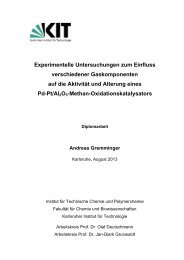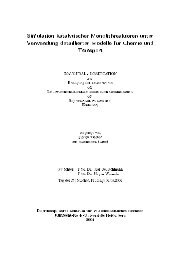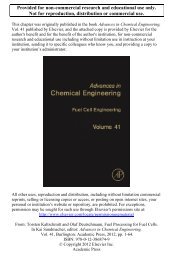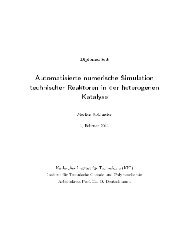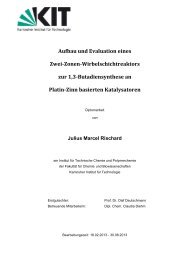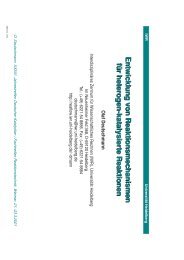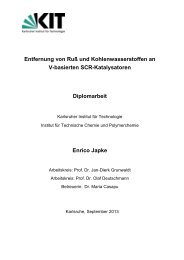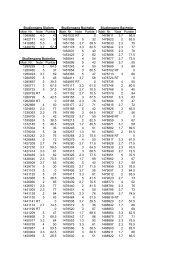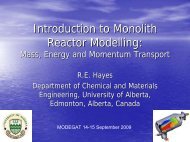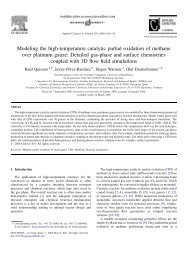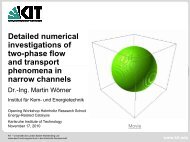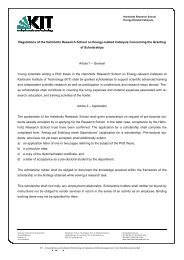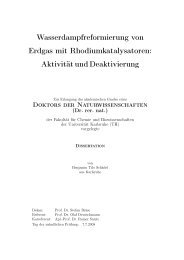SOFC Modeling - From Micro-Kinetics to Stacks - KIT
SOFC Modeling - From Micro-Kinetics to Stacks - KIT
SOFC Modeling - From Micro-Kinetics to Stacks - KIT
Create successful ePaper yourself
Turn your PDF publications into a flip-book with our unique Google optimized e-Paper software.
A0201 – Abstract A021 – Oral Presentation – Session A02 – <strong>Modeling</strong> Sesson – Tuesday, July 1, 2008 – 11:00 h<br />
i zFL<br />
⎡<br />
k k<br />
⎣<br />
Ks<br />
K<br />
υ<br />
s<br />
'<br />
υ''<br />
i<br />
=<br />
tpb ⎢ fi<br />
θk −<br />
ri<br />
θk<br />
k= 1 k=<br />
1<br />
⎤<br />
⎥<br />
⎦<br />
∏ ∏ (16)<br />
Here Ltpb<br />
is the area specific TPB length, Ks<br />
is the <strong>to</strong>tal number of surface species and υ '<br />
and υ '' are the s<strong>to</strong>ichiometric coefficients of the reactants and products, respectively.<br />
Based on the above equation the <strong>to</strong>tal Faradic current is written as<br />
N ct<br />
i = ∑ i , (17)<br />
i<br />
i=<br />
1<br />
N<br />
ct<br />
is the <strong>to</strong>tal number of charge transfer reactions. Based on the potential difference<br />
between the electronic and ionic phases, the operating cell potential can be expressed as<br />
Ecell = Δφc −Δφa − ηohm<br />
(18)<br />
Δφ c<br />
and Δφa<br />
are respectively the potential difference on the cathode and anode side.<br />
The following electrochemical reactions are considered for evaluating the model with<br />
experimental measurements:<br />
−<br />
−<br />
2H[Ni] + O[YSZ]<br />
↔ H2O[YSZ]<br />
+ 2[Ni] + 2e<br />
(19)<br />
−<br />
−<br />
CO[Ni] + O[YSZ]<br />
↔ CO2[YSZ]<br />
+ [Ni] + 2e<br />
(20)<br />
x 1<br />
• • −<br />
O [el] ↔ O2<br />
+ Vo<br />
+ 2e .<br />
2<br />
(21)<br />
4. Stack model<br />
The timescales of various processes such as kinetics, diffusion, and heat transfer<br />
occurring in an <strong>SOFC</strong> stack are different from each other, and the heat transfer process<br />
has a larger time constant compared <strong>to</strong> the rest of the processes. In the method adopted<br />
here, the solid-phase temperature is decoupled from the fluid phase <strong>to</strong> develop the<br />
transient stack model, which solves the transient two or three-dimensional heat conduction<br />
problem. While solving the heat conduction equation, the stack is assumed as a porous<br />
media, consisting of straight channels. The heat balance can then be written as<br />
ρC<br />
p<br />
∂T<br />
∂ ⎛ ∂T<br />
= λij<br />
⎞<br />
+ q<br />
∂t ∂x ⎜<br />
i<br />
x ⎟<br />
⎝ ∂<br />
j ⎠<br />
(22)<br />
Here, t = time, T = temperature, ρ = density, C p = heat capacity, λ ij = tensor of heat<br />
conductivity; q is the heat source term arising from the interaction with the individual cells.<br />
The heat source term is derived from the simulation of individual cells. If the cell density is<br />
σ (cells per unit area of the cross-section), the source term can be expressed as<br />
∂H<br />
cell<br />
q = −σ + Qohm<br />
(23)<br />
∂x<br />
H cell is the enthalpy flux in the cell and Q ohm is the heat release due <strong>to</strong> ohmic heating. The<br />
cell model is used for simulations as reported in [4]. A cluster agglomeration algorithm is<br />
5



